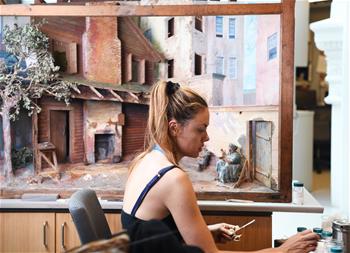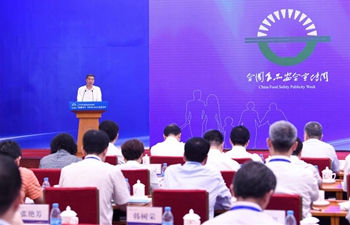LONDON, July 19 (Xinhua) -- The argument for a rise in the British bank rate was strengthened with data on Thursday which showed the retail sector enjoy its strongest period of growth for 14 years.
The retails sales figures for the second quarter of this year were up 2.1 percent quarter on quarter, according to Office of National Statistics (ONS) figures, the strongest quarterly growth since 2004.
The strong figure is a result of very good sector monthly performance in April and May, where sales volumes increased by 1.8 percent and 1.4 percent respectively month on month.
These figures reflect a rebound from a poor overall economic performance in the first quarter, when GDP growth halved from the final quarter of 2017 to 0.2 percent over the quarter, partly influenced by prolonged bad weather.
While the monthly retail sales volumes for June disappointed economists, with a 0.5 percent decline against expectations of 0.2 percent growth, this failed to seriously dent the quarterly figures.
These strong figures, coming on the back of above-inflation pay figures released earlier this week and a record high jobs figure along with unemployment at a low not seen since the 1970s, could give rate-setters on the Bank of England's Monetary Policy Committee (BoE MPC) the go-ahead to increase the rate at its next meeting at the beginning of August.
"The recovery in the consumer sector supports our view that an August interest rate hike is more likely than not," said Ruth Gregory, chief British economist at Capital Economics, a London-based macroeconomic research firm.
Strong retail growth in Q2 had in part been due not just to a bounce back from the poor first quarter but to better-than-average weather and one-off events such as the royal wedding, and is a significant driver of overall economic growth.
"Since retail sales account for a fifth of GDP, this could add as much as 0.4 percentage points to Q2 GDP growth, although any boost is unlikely to be this large given the evidence, for example, from the Bank of England's Agents, of subdued spending growth off the high street," Gregory told Xinhua.
The case for a rate rise (only the second rise since July 2007) from the current 0.5 percentage points has been made by some members of the MPC in recent speeches, and has gained support within the MPC with two members of the nine-strong committee voting for a rate rise at the May meeting, increasing to three members in June.
The lower-than-expected inflation figures earlier this week on Tuesday, with Consumer Price Index (CPI) inflation remaining at 2.4 percent in June against expectations that rising global oil prices would increase it to 2.6 percent will have taken some of the impetus out of calls for a rate rise.
However CPI at 2.4 percent is below the 2.5 percent annual growth in wages, revealed in Wednesday's data, shows easing pressure on consumer spending and bolsters the rate-rise hawks.
Gregory commented: "Crucially, though, the big constraint on spending, namely the squeeze on real wages from high inflation, has eased.
"The retail sales deflator has ticked down a little further, from 2.4 percent to 2.3 percent in June. With real pay rises now in prospect, annual spending growth is expected to pick up this year, from 1.2 percent in Q1 to about 2 percent in mid-2019."













